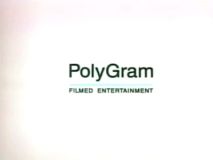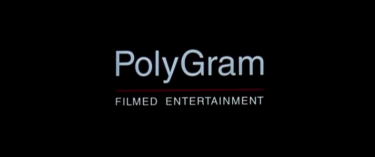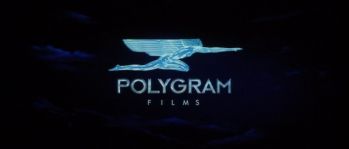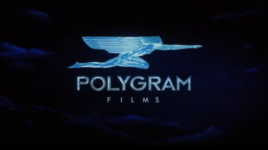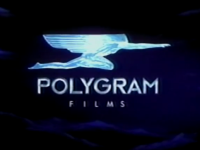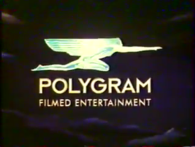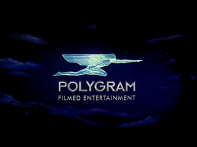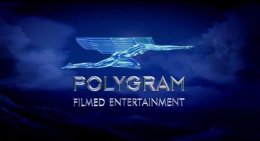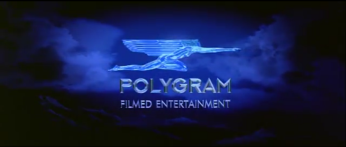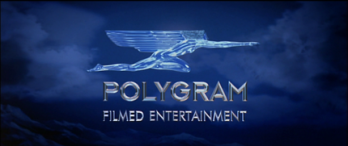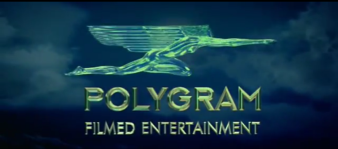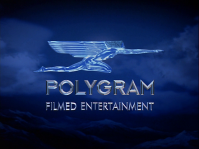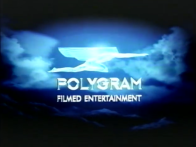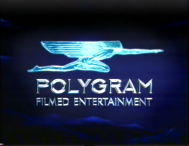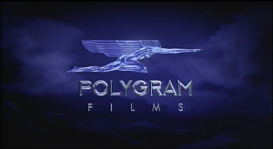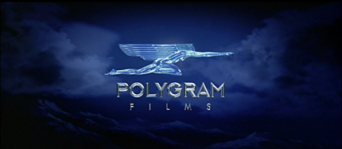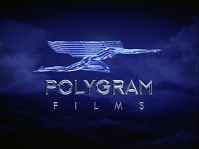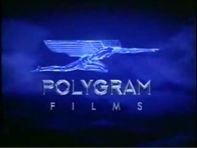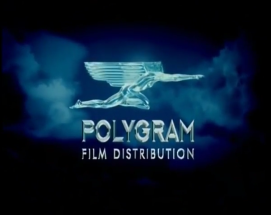PolyGram Filmed Entertainment (UK)
Jump to navigation
Jump to search
The printable version is no longer supported and may have rendering errors. Please update your browser bookmarks and please use the default browser print function instead.
Logo descriptions by codyfinke, Eric S., Supermarty-o, V of Doom, UniversalFlorida1990, and Shadeed A. Kelly
Logo captures by V of Doom, and Eric S.
Editions by thehugetvfan, indycar and UniversalFlorida1990
Video captures courtesy of EnormousRat, LogicSmash, Logo Archive, CraigS1996Entertainment, SpikeyTheDog188, TheRedBaron1985, and Jamster
PolyGram Pictures
Background: PolyGram Pictures was formed in 1979 by producers Jon Peters and Peter Guber. It was the launched as the film division of the PolyGram Records label. Universal Pictures would handle U.S. distribution for a majority of their films (with the exceptions of Wes Craven's Deadly Blessing, Split Image and Flashdance which were distributed by United Artists, Orion Pictures and Paramount Pictures respectively) while Producers Sales Organization would handle distribution outside the US. In 1982, Peters and Guber left PolyGram to form The Guber-Peters Company which would lead to the deactivation of PolyGram Pictures a year later in 1983. Two years later in 1985, MCA Home Video sold the video rights to the PolyGram Pictures library to Vestron Video as a way of cutting losses due to most of these films losing money at the box office. However, the home video rights to Deadly Blessing would go to Embassy Home Entertainment while the rights to Flashdance would remain with Paramount. Universal would eventually regain the distribution rights to some of the PolyGram films they distributed, which included Endless Love, An American Werewolf in London and Missing, among others. Lionsgate holds streaming rights to some PolyGram films such as The Persuit of D.B. Cooper, King of the Mountain and Six Weeks.
1st Logo
Nicknames: "The Red Stars", "Rollercoaster", "PolyCoaster", "A Fountain of Red Stars"
Logo: On a black background, we see red stars going up, which then go down describing a curve (like the 1980 Telepictures Corporation logo), revealing the text:
The stars then are in a line under the name.
Variants:
FX/SFX: The stars forming the name are Scanimate effects.
Music/Sounds: Usually none or the opening theme of the film.
Availability: Appears on An American Werewolf in London, Endless Love, King of the Mountain and Deadly Blessing (preceded by the 1976 United Artists Pictures logo). It can be seen on the 2013 Shout! Factory DVD and Blu-Ray release of the latter. Don't expect to see this on Flashdance (which PolyGram co-produced with Paramount Pictures).
Logo captures by V of Doom, and Eric S.
Editions by thehugetvfan, indycar and UniversalFlorida1990
Video captures courtesy of EnormousRat, LogicSmash, Logo Archive, CraigS1996Entertainment, SpikeyTheDog188, TheRedBaron1985, and Jamster
PolyGram Pictures
Background: PolyGram Pictures was formed in 1979 by producers Jon Peters and Peter Guber. It was the launched as the film division of the PolyGram Records label. Universal Pictures would handle U.S. distribution for a majority of their films (with the exceptions of Wes Craven's Deadly Blessing, Split Image and Flashdance which were distributed by United Artists, Orion Pictures and Paramount Pictures respectively) while Producers Sales Organization would handle distribution outside the US. In 1982, Peters and Guber left PolyGram to form The Guber-Peters Company which would lead to the deactivation of PolyGram Pictures a year later in 1983. Two years later in 1985, MCA Home Video sold the video rights to the PolyGram Pictures library to Vestron Video as a way of cutting losses due to most of these films losing money at the box office. However, the home video rights to Deadly Blessing would go to Embassy Home Entertainment while the rights to Flashdance would remain with Paramount. Universal would eventually regain the distribution rights to some of the PolyGram films they distributed, which included Endless Love, An American Werewolf in London and Missing, among others. Lionsgate holds streaming rights to some PolyGram films such as The Persuit of D.B. Cooper, King of the Mountain and Six Weeks.
1st Logo
(April 4, 1981-April 14, 1982)
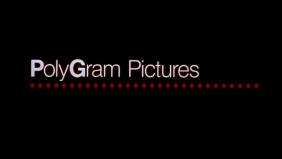
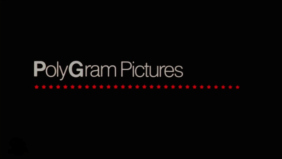
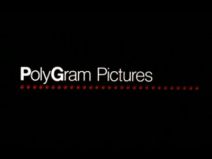
<iframe height="152" src="http://wikifoundrytools.com/wiki/closinglogos/widget/unknown/95009b4cd7239d3d8b5d4531cf44aa7ffb0eb045" width="278"></iframe><iframe height="152" src="http://wikifoundrytools.com/wiki/closinglogos/widget/genericvideo/6b970cb7995a460436525a6ad34258f265a17769" width="276"></iframe><iframe height="152" src="http://wikifoundrytools.com/wiki/closinglogos/widget/genericvideo/4c95e175c05bc947b124a255e564b7a094c61b93" width="285"></iframe>



<iframe height="152" src="http://wikifoundrytools.com/wiki/closinglogos/widget/unknown/95009b4cd7239d3d8b5d4531cf44aa7ffb0eb045" width="278"></iframe><iframe height="152" src="http://wikifoundrytools.com/wiki/closinglogos/widget/genericvideo/6b970cb7995a460436525a6ad34258f265a17769" width="276"></iframe><iframe height="152" src="http://wikifoundrytools.com/wiki/closinglogos/widget/genericvideo/4c95e175c05bc947b124a255e564b7a094c61b93" width="285"></iframe>
Nicknames: "The Red Stars", "Rollercoaster", "PolyCoaster", "A Fountain of Red Stars"
Logo: On a black background, we see red stars going up, which then go down describing a curve (like the 1980 Telepictures Corporation logo), revealing the text:
PolyGram Pictures
The stars then are in a line under the name.
Variants:
- An early variant features the stars and name wiping, without any animation at all.
- On An American Werewolf in London, the logo cuts to black instead of fading to black at the end.
FX/SFX: The stars forming the name are Scanimate effects.
Music/Sounds: Usually none or the opening theme of the film.
Availability: Appears on An American Werewolf in London, Endless Love, King of the Mountain and Deadly Blessing (preceded by the 1976 United Artists Pictures logo). It can be seen on the 2013 Shout! Factory DVD and Blu-Ray release of the latter. Don't expect to see this on Flashdance (which PolyGram co-produced with Paramount Pictures).
2nd Logo
(November 13, 1981)
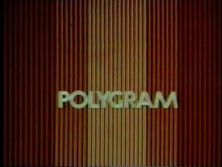 <iframe height="164" src="http://wikifoundrytools.com/wiki/closinglogos/widget/genericvideo/9f975054ac9f6d9702aec8c4471b74e03b2ee53c" width="294"></iframe>
<iframe height="164" src="http://wikifoundrytools.com/wiki/closinglogos/widget/genericvideo/9f975054ac9f6d9702aec8c4471b74e03b2ee53c" width="294"></iframe>
Nicknames: "Rainbow PolyGram", "PolyRainbow"
Logo: On a background of red, orange and yellow stripes, we see the words "POLYGRAM" in a Prisma-like font near the middle of the screen.
FX/SFX: None.
Music/Sounds: None.
Availability: Very rare. The only known movie to feature this logo is The Pursuit of D.B. Cooper. Preserved on digital prints and the 1982 MCA Videocassette VHS release of the said movie.
Editor's Note: Several in the logo community consider this logo to be an ugly one, due to its color scheme.
_______________________________________________________________________________
PolyGram Filmed Entertainment
Background: In 1986, PolyGram Pictures was relaunched as "PolyGram Filmed Entertainment". The reorganized film unit was based in England and became a European competitor to Hollywood. However, they didn't enter full US distribution or used a logo until 1992. Prior to that, PolyGram often used other US distributors for their some of their films such as The Samuel Goldwyn Company (Wild at Heart and Fear, Anxiety & Depression) and New Line Cinema (Drop Dead Fred, Fools of Fortune and Chicago Joe and the Showgirl). Between 1990 and 1995, PolyGram would aquire several production companies such as Working Title Films, Propaganda Films, Interscope Communications, Island Pictures and ITC Entertainment, among others. They also formed 2 other labels as well: Gramercy Pictures in 1992 (which was launched as a joint venture between PolyGram and Universal Pictures. It also acted as an art house label for Universal and a US distributor for PolyGram) and Rogue Pictures in 1997 (which was launched as a low budget label for PolyGram). In 1998, PolyGram was acquired by Seagram & Sons and operated until 1999 when it was shut down and folded into Universal Studios. In 1999, Seagram & Sons sold most of the pre-March 31, 1996 library to Metro-Goldwyn-Mayer and it was incorporated into their Orion Pictures library. Currently, most of the pre-March 31, 1996 PolyGram film library, including most films from Island Pictures, the entire Atlantic Releasing Corporation library (through Island), and the Epic library (which PolyGram had acquired in 1997), is owned by MGM while Universal owns the rights to some pre-March 31, 1996 films (Backbeat, Before the Rain, Hate (also known as La Haine), The Jacksons: An American Dream, Drop Dead Fred (in the UK only) and Cold Blooded) and the rest of PolyGram's films until its disestablishment.
1st Logo
(September 4, 1992-1998)
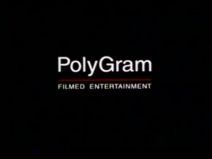
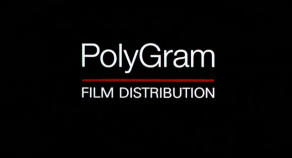
<iframe height="134" src="http://wikifoundrytools.com/wiki/closinglogos/widget/genericvideo/066cfae961ea00a9acde73b55d5810033349aef7" width="240"></iframe><iframe height="134" src="http://wikifoundrytools.com/wiki/closinglogos/widget/genericvideo/cabddc8ef78d28adbf1fb34a63cf54eaa85b9440" width="241"></iframe><iframe height="134" src="http://wikifoundrytools.com/wiki/closinglogos/widget/genericvideo/fe458c91eba5e3614095017c477a58e64fa9b318" width="241"></iframe><iframe height="134" src="http://wikifoundrytools.com/wiki/closinglogos/widget/genericvideo/217a484862ca3b7bab771c0425f8763de5fc2296" width="239"></iframe>
Nicknames: "The Drawing Red Line", "PolyLine"
Logo: On a black background, "PolyGram" appears. Then "FILMED ENTERTAINMENT" appears under the name. A red line is drawn between "PolyGram" and "FILMED ENTERTAINMENT", which causes a red flash after it stops drawing, then it shines once.
Variants:
FX/SFX: The "drawing red line" effect.
Music/Sounds: Usually none or the opening theme of the film.
Availability: Uncommon.
2nd logo
(September 12, 1997-1999)
Nicknames: "PolyGram Winged Man", "Icarus", "The Crystal Wingman"
Logo: On a ominously-dark cloudy sky-scape, we see a transparent, crystallized winged man standing against some mountains. The camera pans outward as he jumps up and remains in the air, as his wings move back and forth. The camera pans to his left as he freezes in the air, where several white streaks appear across his body. The silver word "POLYGRAM" flies under the man and centers in place as he flashes white all over and becomes still. "FILMED ENTERTAINMENT" (or "FILMS") appears under "POLYGRAM", and everything shines.
Trivia: This logo was designed by Michael J. Deas, the same person who painted and designed the 1992 Columbia Pictures and 1993 Merv Griffin Enterprises logos. The logo was based off of the sculpture "Speed" by Harriet Whitney Frishmuth, intended as a hood ornament for cars by the Gorham Manufacturing Company. It may also possibly be based off of the ancient Greek statue known as The Winged Victory of Samothrace.
Variants:
FX/SFX: The winged man moving and the letters appearing. Even decades later this is very good, beautiful animation for 1997.
Music/Sounds: None or the opening theme of the film.
Availability: Very rare. This was used for only three years, and later home media releases as well as most television airings of films that originally used this logo have it plastered by the 1997 Universal logo.
Editor's Note: In spite of its short life-span, this is a very well-renowned logo thanks to its gorgeous atmosphere and impressive CGI for the time. Some users of the CLG Wiki perceive the winged man to be based off of Icarus, the man from the Greek fable who constructed a set of wax wings and tried to fly to the sun before falling in the sea. However, considering the origins of the logo, it's possible that it wasn't supposed to be representative of Icarus.
 <iframe height="164" src="http://wikifoundrytools.com/wiki/closinglogos/widget/genericvideo/9f975054ac9f6d9702aec8c4471b74e03b2ee53c" width="294"></iframe>
<iframe height="164" src="http://wikifoundrytools.com/wiki/closinglogos/widget/genericvideo/9f975054ac9f6d9702aec8c4471b74e03b2ee53c" width="294"></iframe>Nicknames: "Rainbow PolyGram", "PolyRainbow"
Logo: On a background of red, orange and yellow stripes, we see the words "POLYGRAM" in a Prisma-like font near the middle of the screen.
FX/SFX: None.
Music/Sounds: None.
Availability: Very rare. The only known movie to feature this logo is The Pursuit of D.B. Cooper. Preserved on digital prints and the 1982 MCA Videocassette VHS release of the said movie.
Editor's Note: Several in the logo community consider this logo to be an ugly one, due to its color scheme.
_______________________________________________________________________________
PolyGram Filmed Entertainment
Background: In 1986, PolyGram Pictures was relaunched as "PolyGram Filmed Entertainment". The reorganized film unit was based in England and became a European competitor to Hollywood. However, they didn't enter full US distribution or used a logo until 1992. Prior to that, PolyGram often used other US distributors for their some of their films such as The Samuel Goldwyn Company (Wild at Heart and Fear, Anxiety & Depression) and New Line Cinema (Drop Dead Fred, Fools of Fortune and Chicago Joe and the Showgirl). Between 1990 and 1995, PolyGram would aquire several production companies such as Working Title Films, Propaganda Films, Interscope Communications, Island Pictures and ITC Entertainment, among others. They also formed 2 other labels as well: Gramercy Pictures in 1992 (which was launched as a joint venture between PolyGram and Universal Pictures. It also acted as an art house label for Universal and a US distributor for PolyGram) and Rogue Pictures in 1997 (which was launched as a low budget label for PolyGram). In 1998, PolyGram was acquired by Seagram & Sons and operated until 1999 when it was shut down and folded into Universal Studios. In 1999, Seagram & Sons sold most of the pre-March 31, 1996 library to Metro-Goldwyn-Mayer and it was incorporated into their Orion Pictures library. Currently, most of the pre-March 31, 1996 PolyGram film library, including most films from Island Pictures, the entire Atlantic Releasing Corporation library (through Island), and the Epic library (which PolyGram had acquired in 1997), is owned by MGM while Universal owns the rights to some pre-March 31, 1996 films (Backbeat, Before the Rain, Hate (also known as La Haine), The Jacksons: An American Dream, Drop Dead Fred (in the UK only) and Cold Blooded) and the rest of PolyGram's films until its disestablishment.
(September 4, 1992-1998)


<iframe height="134" src="http://wikifoundrytools.com/wiki/closinglogos/widget/genericvideo/066cfae961ea00a9acde73b55d5810033349aef7" width="240"></iframe><iframe height="134" src="http://wikifoundrytools.com/wiki/closinglogos/widget/genericvideo/cabddc8ef78d28adbf1fb34a63cf54eaa85b9440" width="241"></iframe><iframe height="134" src="http://wikifoundrytools.com/wiki/closinglogos/widget/genericvideo/fe458c91eba5e3614095017c477a58e64fa9b318" width="241"></iframe><iframe height="134" src="http://wikifoundrytools.com/wiki/closinglogos/widget/genericvideo/217a484862ca3b7bab771c0425f8763de5fc2296" width="239"></iframe>
Logo: On a black background, "PolyGram" appears. Then "FILMED ENTERTAINMENT" appears under the name. A red line is drawn between "PolyGram" and "FILMED ENTERTAINMENT", which causes a red flash after it stops drawing, then it shines once.
Variants:
- There is an earlier version where the background is white, the words are already faded in, and the line is light blue.
- On some movies, "FILM DISTRIBUTION" replaces "FILMED ENTERTAINMENT". This can be spotted on the 1998 film, Le Clone.
- There is a scope variant where the logo is cropped from 1.85 to 2.35 to fit the aspect ratio. This can be spotted on Moonlight and Valentino, French Kiss (which was a co-production with 20th Century Fox) and the theatrical trailers for The Game.
FX/SFX: The "drawing red line" effect.
Music/Sounds: Usually none or the opening theme of the film.
Music/Sounds Variant:
- The 1999 Universal Studios Home Entertainment United Kingdom DVD of Twelve Monkeys uses the last half of the fanfare from the 1990 Universal logo, due to an editing mistake.
- On Bean Scenes Unseen and Bean: The Ultimate Disaster Movie, a ding can be heard when the logo flashes.
Availability: Uncommon.
- Found on most 1992 to 1997 PolyGram films, most notably Posse, Romeo is Bleeding, Jason's Lyric, Four Weddings and a Funeral, Dead Man Walking, Kalifornia (1997 PolyGram Video DVD and 2000 MGM DVD releases only, the 1994 PolyGram Video VHS release and current prints have this logo removed), A Gnome Named Gnorm (1994 PolyGram Video VHS release only, plastered by the 2005 Lionsgate Films logo on current prints due to PolyGram only handling that home media release and Lionsgate owning the film through producer Vestron Pictures), Fargo, The Adventures of Priscilla: Queen of the Desert (but not on the 1995 PolyGram Video VHS release) and Bean, among others.
- Also seen on United Kingdom trailers for PolyGram films, some which can be found on VHS releases in the United States by PolyGram Video.
- Appears on the PolyGram Video United Kingdom VHS, some 1996 US VHS prints, and 1999 MGM US DVD of The Usual Suspects.
- This logo is not on Shallow Grave, the Tim Burton and Joel Schumacher Batman films (which PolyGram gets credited as a producer on due to Jon Peters and Peter Guber producing the films and PolyGram receiving a portion of the films' earnings as part of Peters's and Guber's departure from the studio), The Matchmaker or any pre-1992 PolyGram films.
- It is unknown if this appears on any video prints of The Basketball Diaries, which they acquired through its purchase of Island World a few months before its theatrical release.
- On newer prints of post-1996 films, and pre-1996 films that they own, this is plastered with the 1997 Universal logo.
- Strangely, this is seen on current prints of The Borrowers (which originally used the next logo) when it last aired on Disney XD, Discovery Family and Netflix and on the Universal DVD as well (after the 1997 Universal logo respectively).
- The inverted variant can be seen on The Jacksons: An American Dream on TV One, VH1 and VH1 Classic, although it's plastered by the short version of the 1997 Universal logo on BET and Centric broadcasts and on the Motown DVD releases.
2nd logo
(September 12, 1997-1999)
<iframe height="164" src="http://wikifoundrytools.com/wiki/closinglogos/widget/genericvideo/be3463a2ff637e191d8de686852ce1fde603666f" width="198"></iframe>
Nicknames: "PolyGram Winged Man", "Icarus", "The Crystal Wingman"
Logo: On a ominously-dark cloudy sky-scape, we see a transparent, crystallized winged man standing against some mountains. The camera pans outward as he jumps up and remains in the air, as his wings move back and forth. The camera pans to his left as he freezes in the air, where several white streaks appear across his body. The silver word "POLYGRAM" flies under the man and centers in place as he flashes white all over and becomes still. "FILMED ENTERTAINMENT" (or "FILMS") appears under "POLYGRAM", and everything shines.
Trivia: This logo was designed by Michael J. Deas, the same person who painted and designed the 1992 Columbia Pictures and 1993 Merv Griffin Enterprises logos. The logo was based off of the sculpture "Speed" by Harriet Whitney Frishmuth, intended as a hood ornament for cars by the Gorham Manufacturing Company. It may also possibly be based off of the ancient Greek statue known as The Winged Victory of Samothrace.
Variants:
- A prototype version of the logo exists, where it was just the Icarus and the word "POLYGRAM" in a stylistic font. Then either "FILMS" or "FILMED ENTERTAINMENT" in a smaller font fades in.
- Some direct-to-video releases, such as Cats, refer to the company as "POLYGRAM VISUAL PROGRAMMING".
- There is a cut short videotaped variant that can be found on several UK VHS releases such as Spice World.
- An open matte version can be found on the theatrical trailer for Barney's Great Adventure.
- There are two variants done for some films shot in the 2.35 aspect ratio. There is one where the 1.85 variant is cropped to 2.35 to accommodate the scope format. The other one is where the 4:3 version is cropped to 2.35. The cropped 1.85 version can be found on the PolyGram Video DVD of Your Friends and Neighbors. The cropped 4.3 version plasters over the prototype version on some prints of The Game.
- Another variant exists where "FILM DISTRIBUTION" replaces "FILMED ENTERTAINMENT". This can be spotted on a French trailer for The Borrowers.
- On a promotion seen before the warning screen of the French VHS tape of Spice World, the cut-short version of the logo is seen with a dark yellow tint.
FX/SFX: The winged man moving and the letters appearing. Even decades later this is very good, beautiful animation for 1997.
Music/Sounds: None or the opening theme of the film.
Availability: Very rare. This was used for only three years, and later home media releases as well as most television airings of films that originally used this logo have it plastered by the 1997 Universal logo.
- Theatrically, the "FILMED ENTERTAINMENT" variant was seen outside of the US, while the "FILMS" variant appeared on PFE's "tentpole" features in the US, including The Game, The Borrowers, Barney's Great Adventure, What Dreams May Come, Very Bad Things, Return to Paradise, and The Proposition. PFE's other films would use the Gramercy Pictures logo in the US instead.
- Can be found on PolyGram Video VHS and DVD releases of films such as Barney's Great Adventure, The Big Lebowski, Elizabeth, Clay Pigeons, The Borrowers, and Lock, Stock, and Two Smoking Barrels, among others.
- The earlier version with "FILMS" can be seen on The Game (where the logo debuted), a teaser trailer and a <a href="https://www.youtube.com/watch?v=VWOeNQonTR4" target="_self" title="TV spot">TV spot</a> for The Borrowers and a trailer for Barney's Great Adventure which can be found on the Lyrick Studios VHS release of Barney: It's Time for Counting!.
- The "FILMED ENTERTAINMENT" variant of the first version can be seen on Dead Letter Office, the United Kingdom trailer for The Game, and the theatrical trailer for The Borrowers.
- When Universal Studios Home Entertainment reissued PolyGram Video/USA Home Entertainment DVD releases from 2002 to 2004, they re-released the PolyGram manufactured discs in their original packaging, but edited out almost all references to said company on the cases (however, it would be likely that films from this time frame released in this method would preserve this logo).
- Also found intact on a 2008 Showtime airing of The Hi-Lo Country, as well as a Hulu print of Your Friends & Neighbors.
- The "FILMS" variant was seen on theatrical prints of The Borrowers and on a TMC on Demand print of What Dreams May Come (the VHS and original DVDs of both films used the "FILMED ENTERTAINMENT" variant).
- One of few films, if not the only one, to retain this on all current prints is Barney's Great Adventure: The Movie, where it's sometimes preceded by the Universal logo, especially since 2014 when Mattel (a Universal partner) acquired the HiT Entertainment library.
- Don't expect to see this on American prints of Spice World (which was released in the US by Columbia Pictures though PolyGram released it in the UK).
- It may appear on the Kino Lorber Blu-ray release of The Gingerbread Man, which, if confirmed, would mark its Blu-ray debut.
Editor's Note: In spite of its short life-span, this is a very well-renowned logo thanks to its gorgeous atmosphere and impressive CGI for the time. Some users of the CLG Wiki perceive the winged man to be based off of Icarus, the man from the Greek fable who constructed a set of wax wings and tried to fly to the sun before falling in the sea. However, considering the origins of the logo, it's possible that it wasn't supposed to be representative of Icarus.
